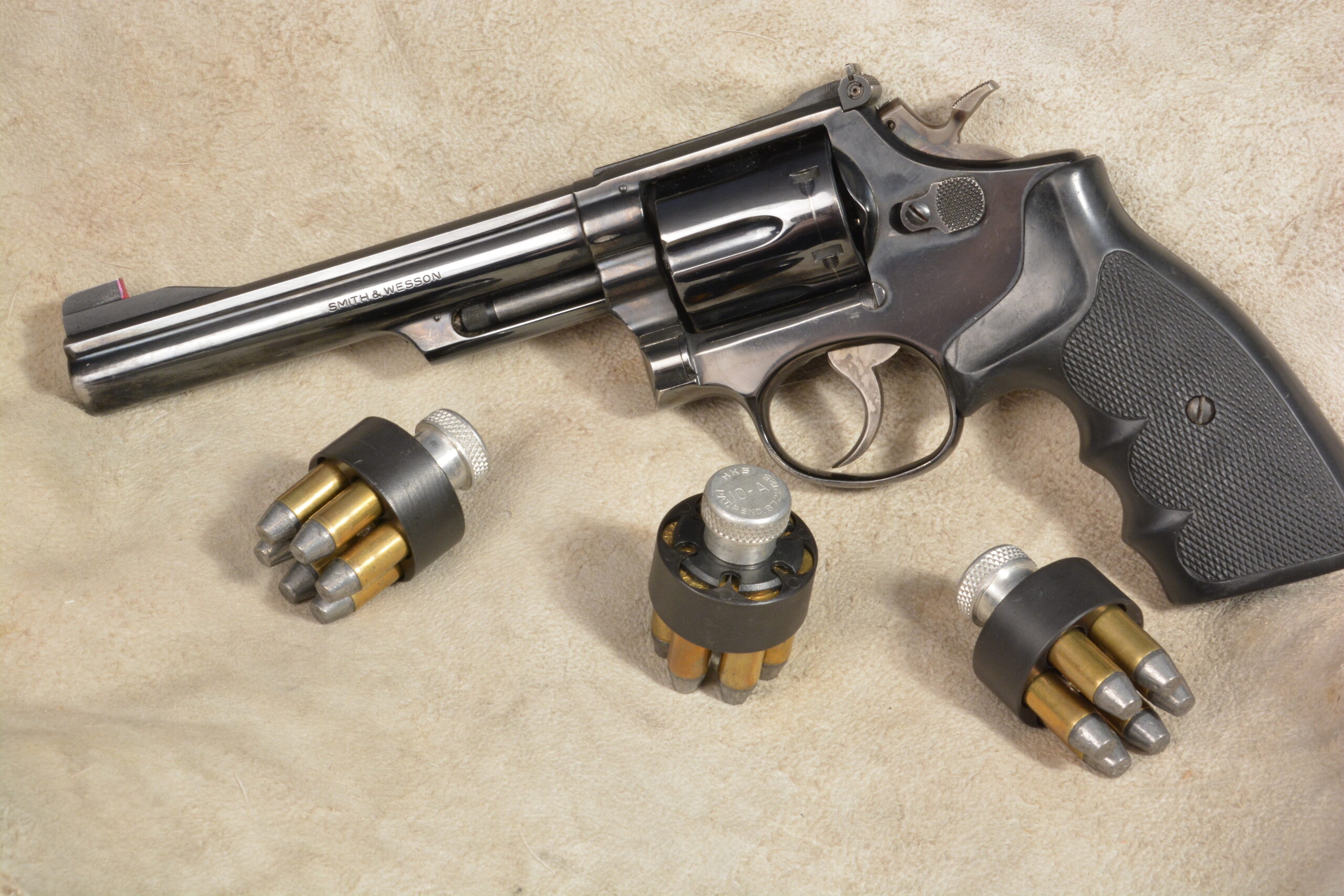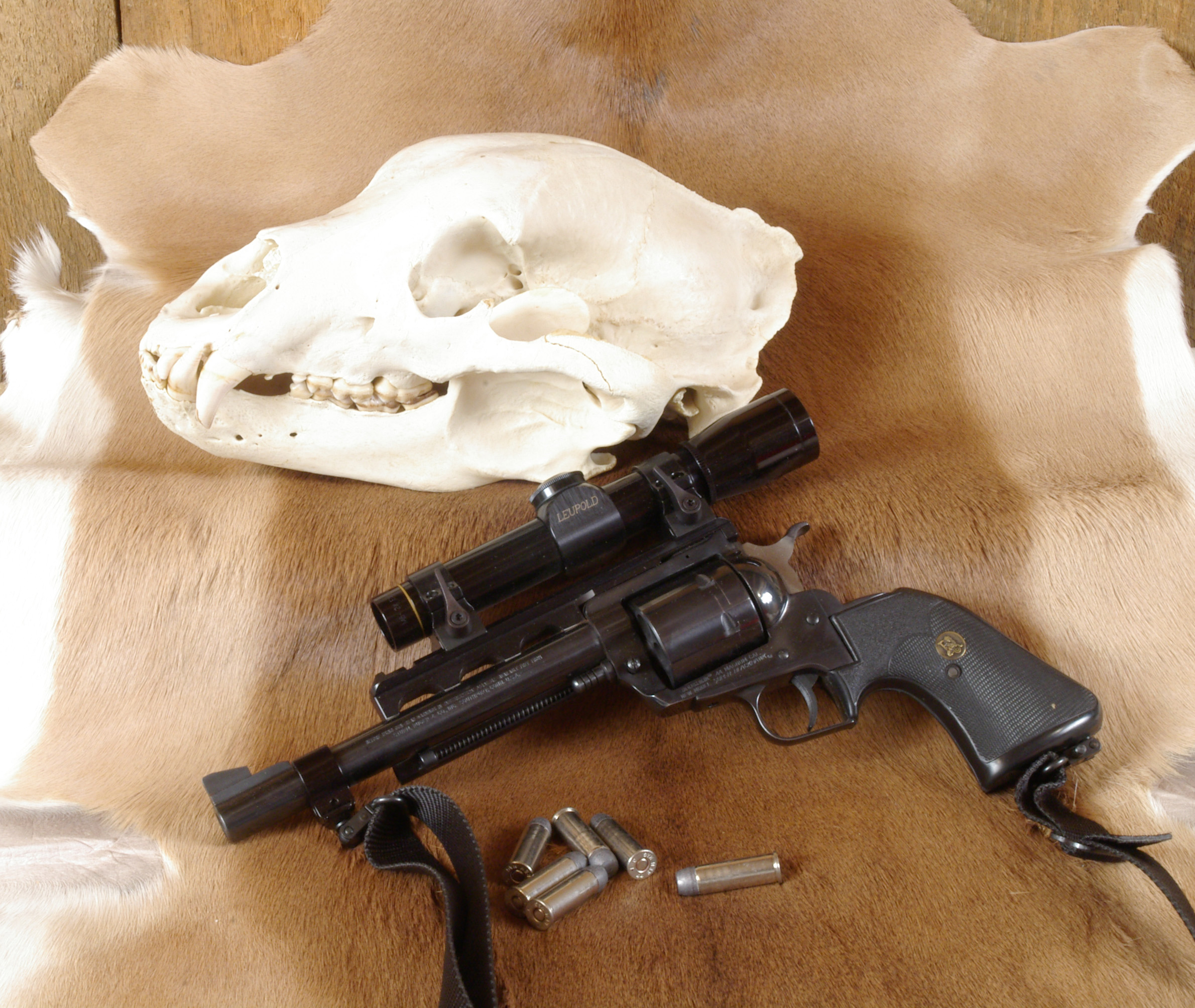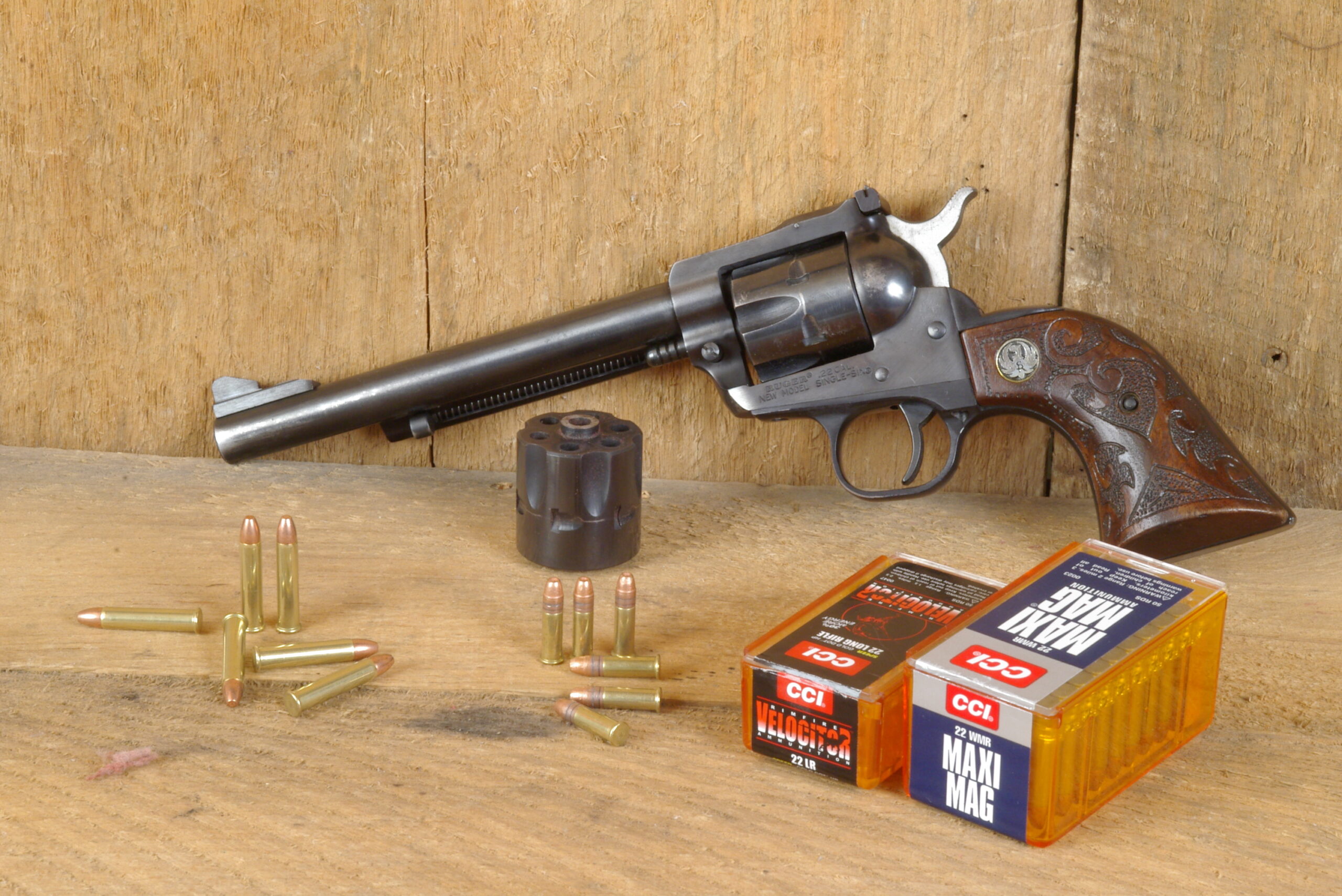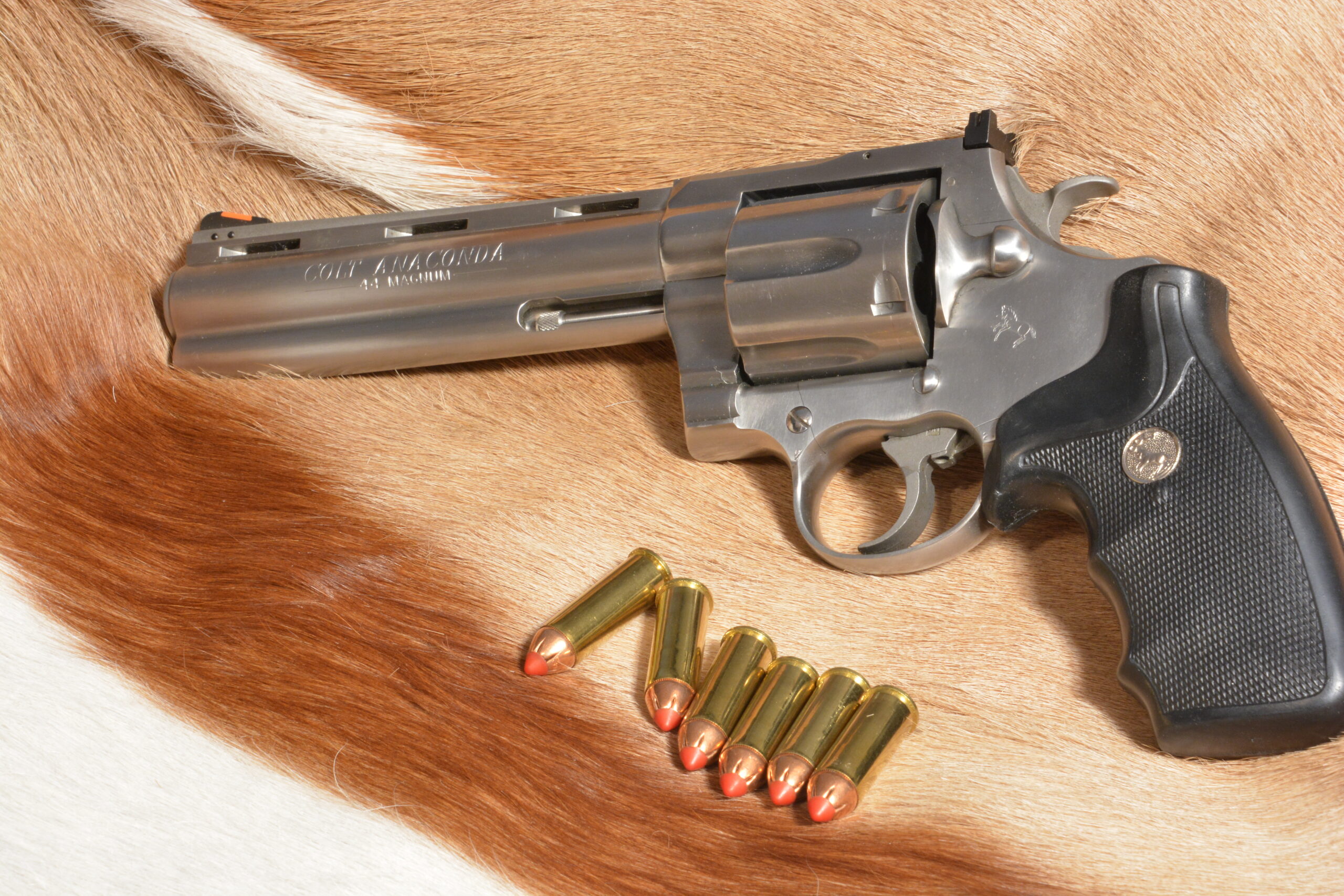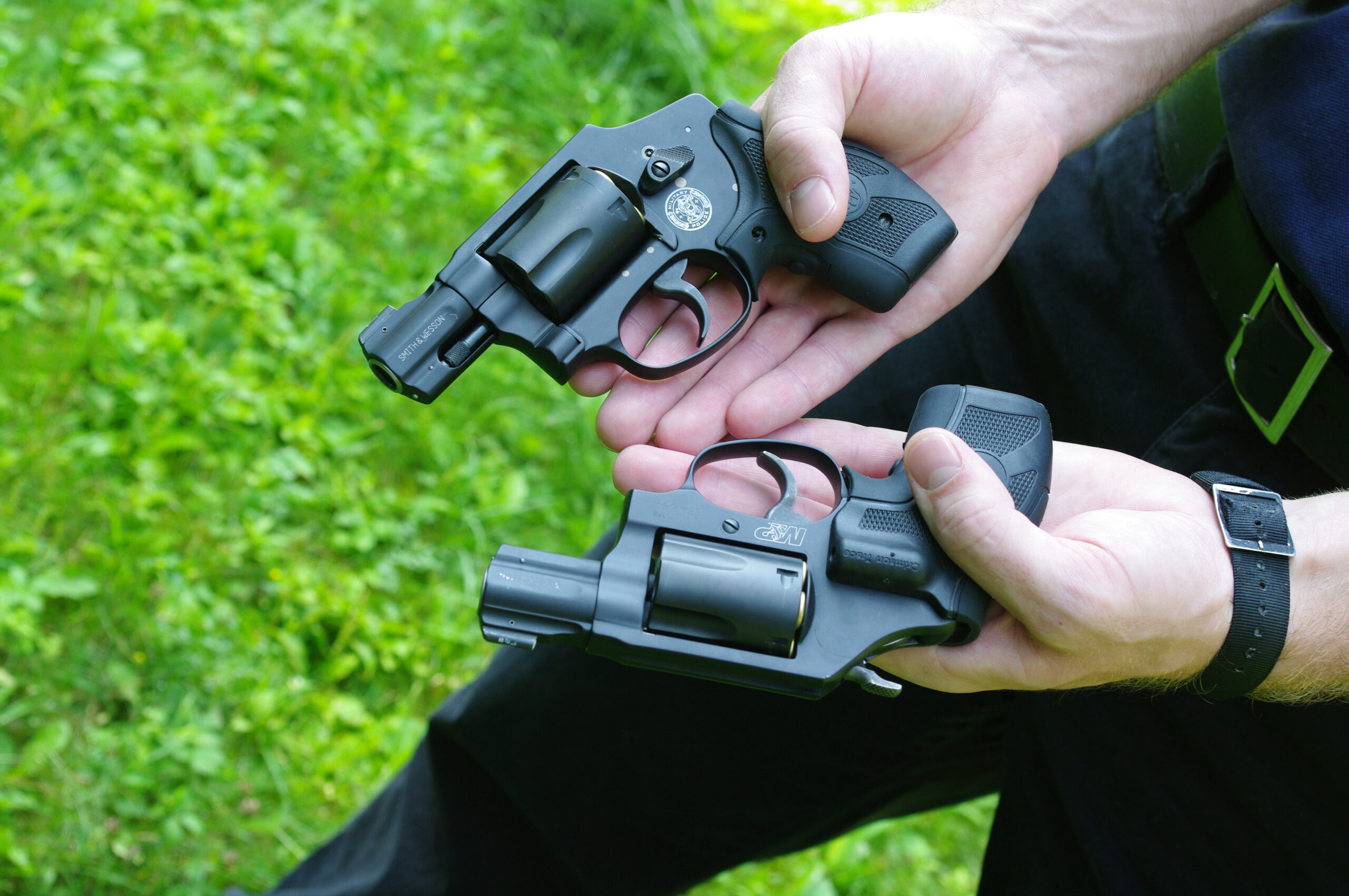We may earn revenue from the products available on this page and participate in affiliate programs. Learn More ›
Updated Mar 20, 2023 4:56 PM
One of the biggest advancements in firearms was repeating firearms. The revolver was the first successful repeating handgun, and even today, the basic design has remained the same. A revolving cylinder is fitted into the frame with a handle on the bottom. That cylinder has holes drilled in which the charges or cartridges are fitted. This cylinder turns on a pivot pin in the center to align each hole in the cylinder in turn with the barrel and the firing mechanism.
The first recorded revolver is an 8-shot, manually rotated, flintlock revolver made in 1597. It belonged to the officer Georg von Reichwein from Hessen in Germany. It’s a very interesting piece of gun building, but didn’t catch on.
The modern design revolver has been around since 1830 when Sam Colt was bored while crossing the ocean on a slow boat and carved out a wooden model of a revolver. He is arguably said to have invented the modern revolver with that model. By 1836, he was producing the Colt Patterson, named for Patterson, N.J., where he made the guns. A neat feature on this gun was that the trigger was hidden inside the frame until the gun was cocked.
Colt made a huge mistake when he dismissed an idea from one of his gunsmiths, Rollin White. White had an idea of a “bored-through” revolver cylinder to allow the use of metallic cartridges in a handgun. After Colt fired White for daring to suggest an improvement to his revolver design, White took his idea to Smith & Wesson. They patented his invention and blocked Colt from building cartridge firearms for almost 20 years.
It was that concept—drilled-through cylinders to allow the use of pre-loaded cartridges—which launched the revolver into what we see as the modern design. Of course there have been a multitude of improvements and changes, but if you put a revolver from today next to one from the late eighteen hundreds it is easy to tell they are the same species.
The Smith & Wesson Model 1 was the first revolver to use self-contained cartridges. Later, in 1873 after the patent ran out, Colt introduced the Single Action Army pistol, perhaps the most famous revolver in history. It’s the gun that inspired the epitaph; “God created men, Col. Colt made them equal.”
The Single Action Army Colt, along with the .45 Colt centerfire cartridge, solidified American’s love affair with revolvers, one that still runs hot even today, nearly 200 years after Colt carved the prototype.
Here’s a look at what I consider some of the best revolvers for outdoorsmen and women. While these are mostly for outdoorsmen, some of these guns could also be considered the best concealed carry revolvers. Certainly, some of these are perfect for protection against lions and tigers and bears in the wilderness. Many of them work pretty well for two-legged threats, too. For example, I carry a S&W J-Frame in .357 every place I go, that may be woodcock hunting or it may be shopping for dinner. The Model 19 S&W with a shorter barrel was the preferred gun of many law enforcement people and those civilians who carried concealed for many years. Today, in the 4-inch version offered by S&W, it’s still a great carry option.
The Best Revolvers: Reviews & Recommendations
Best Single Action: Freedom Arms Model 83
In the Dirty Harry era, the .44 Magnum was “The most powerful handgun in the world.”
The .454 Casull took that title and when Freedom Arms in Wyoming started making revolvers, I had to have one. It took a while as the Freedom Arms revolvers are not cheap. But they are worth every penny. They are built with the precision of a Swiss watch and the strength of an Abrams Tank.
That first Freedom Arms Model 83 came with a standard 7.5-inch barrel. I mounted a Leupold scope on it with a J.D. Jones T’SOB mount and took it to the woods. I have lost count of the critters I have shot with that Model 83. Deer, bears, hogs plus a lot of smaller game. I have shot it a bunch at the range working up loads and practicing, yet that gun is just as tight as the day I got it 33 years ago.
It once hit a black bear so hard that my pal, Bill Ingalls shook his head and said, “That’s the deadest got’damned bear I have ever seen.” Bill ran bear dogs for decades and had seen a lot of dead bears.
While deer hunting in south Alabama, another hunter in camp and I both shot deer one morning. The two blood trails couldn’t have been more different. While helping the other hunter follow the skimpy blood trail that had given him hours of frustration, it intersected the one from my deer.
“All I could think of was Crocodile Dundee and his knife,” He said. “I actually shouted out loud, ‘Now, THAT’S a blood trail!’”
I have others now. Another 5-inch barrel, .454 that Ken Kelly at Mag-na-Port tricked out for me as a carry gun in bear country, and also Model 83 revolvers chambered for .50 AE and FA proprietary .50 Wyoming Express, a cartridge that I would use to hunt T-Rex if they ever get this cloning thing worked out. I feel confident that nobody will argue when I say the Freedom Arms Model 83 is the finest single action revolver that’s ever been made. If you want the best revolver for hunting that you can pass on to your children, get a Freedom Arms.
Best .357: Smith & Wesson Model 19
The 1935 introduction of the .357 Magnum was significant as it was the first revolver cartridge that was truly suitable for hunting. Sure Elmer Keith was hot-rodding the .45 Colt and the .44 Special, but neither of these were big game appropriate with factory loaded ammo.
The .357 came out in the large frame gun that would later be the Model 27. It was a wonderful piece of gun making art. As an aside, I once had a chance to buy one for a few peanuts. But I had a new job, a new house and a new kid. I had no peanuts. That’s the gun that haunts my dreams. I wish I could go back in time and scrounge up the dough to buy that revolver.
The large frame, called the N frame, is a bit of a heavy handgun in .357. So when in 1957 S&W introduced the smaller, lighter K frame in .357 and called it the Model 19, things changed.
Designed for cops, this was also a gun for hunters and outdoorsmen. It was meant to be carried. The experts all said it would shoot apart with a lot of magnum use, but they really didn’t. Most outdoorsmen never shot that much anyway. Neither did cops, for that matter.
I picked up mine used, it’s a six inch barrel with a Partridge style front sight. I used it for PPC competition with .38 Special wadcutters as well as for hunting with full power cast bullet loads. I recently had a reunion with an old shooting buddy from the seventies and he asked about the gun, “you were always tinkering on that thing, do you still have it?”
I do and it’s tuned to perfection. For many years I carried it whenever I was out and about in the woods. With that handgun and handloaded ammo I have taken every critter legal to shoot in my home state of Vermont, except bobcat and black bear.
I truly believe that cartridges and guns have soul mates. For example the .30-30 and the Model 94 Winchester. They are symbiotic and one would not have survived without the other. They are a perfect match. For the .357 Magnum, the Model 19 is “the one.” S&W foolishly dropped it for a while, but thankfully they came to their senses and it’s back in the catalog.
Best .44 Magnum: Ruger Super Blackhawk
It’s 1955 and Smith & Wesson and Remington are feverishly working under a cloak of secrecy, developing the Model 29 revolver and the .44 Magnum cartridge. I guess they weren’t all that good at the “secret” part because somebody found some spent cases in the trash and they made their way to Bill Ruger’s desk. Ruger called all his friends at Remington to ask about the cartridge and they wouldn’t tell him anything.
In typical Bill Ruger fashion, he said “to hell with them, then” and built a new .44 Magnum Blackhawk by reverse engineering the cases. Ruger got his pistol to market in 1956 ahead of S&W and the Model 29.
The .44 Magnum Blackhawk was in production until 1959 when it evolved into the Super Blackhawk. This beefier handgun remains one of the top hunting handguns ever made. The Model 29 S&W, the gun most associated with the introduction of the .44 Magnum, was a wonderful gun, but it had a few flaws. That it fell to pieces if shot too much was one. That surfaced when Handgun Metallic Silhouette shooting took off in the late seventies. For years, Smith & Wesson refused to admit there was a problem and it wasn’t long before Ruger’s dominated the revolver class.
The Super Blackhawk is kind of like a rock, in that you need to work very hard to break it. One of mine digested about six gazillion full power loads when I was competing and it still functions like the day it was made. It’s the gun I used to shoot my first handgun deer with. I used my other Super Blackhawk to shoot my first ever black bear. For a hunter looking for a .44 Magnum revolver to carry in the wilderness for bear protection or to shoot whitetails in the back forty, the Ruger Super Blackhawk has no rival as the best revolver in .44 magnum.
Best .22 LR: Ruger Single-Six
Speaking of Bill Ruger and his genius, let’s look at his first single action revolver. The Great War was over, Colt had stopped production on single action revolvers and the market was all about automatics and double action revolvers. So Ruger decided to build a single action revolver. All the “experts” told him he was crazy and that nobody would buy it.
With that gun, he introduced investment casting to the gun making world, something that was unheard of. “It will never work,” all the experts were in agreement on that. “Ruger has lost his marbles,” they said. “This will be the end of him and his company.”
Then a well-known writer at the time, Pete Kuhlhoff, ran a small mention in Argosy magazine and it broke the Southport Post Office. Seems Americans did indeed want a single action handgun.
The Single Six is a scaled down single action in a size that works with the .22 LR (and the .22 WMR, as a lot of them came with both cylinders.) Big enough to feel like a real gun and fit in an adult hand, yet light enough to carry on your belt all day. It became the companion handgun of millions of hunters, fishermen, trappers, campers and woods ramblers.
The Single-Six is a delightful handgun, not just light to carry, but extremely accurate. When I first got into Bullseye shooting competition, it was the only .22 handgun I owned. Nobody ever told me it wouldn’t work, well nobody I listened to anyway. My scores were fine. I later updated to a S&W Model 41, the ultimate Bullseye competition gun. A year later I found out that there are pistol shooting competitions that move faster than drying paint and I left Bullseye behind. About that time I also entered my trapping phase. For about four or five years, two of them full time, that little Ruger was on my belt every single early morning as I headed out to tend my line. The gun accounted for a lot of fur and a lot of small game. I even shot a deer with it one time, a finishing shot. Twice it saved me from a pissed-off skunk in a trap. (Who knew they could be so vindictive?)
Best Comeback: Colt’s Big Snake Guns
My first handgun was a S&W .357 Model 28. I was so proud that the next day at work I showed it around the shop. (Different times.) Until one guy said, “big deal, it’s not a Python.”
While I am still a little hurt, he was right. The Python was considered the premier .357 Magnum, double-action revolver of the time.
Colt, of course, blew it and the gun went out of production before I could get my hands on one. No problem, I figured I could always pick up a used one. Then the Walking Dead started showing greasy Rick, holding his Python in his limp-wristed grip and it blew up demand. Prices rose to absurd levels.
So, no Python for me. I did, however somewhere along the line manage to acquire its big brother, the Anaconda, in .44 Magnum.
Finally, the Python is back in production. I shot one recently and fell in love. I was shooting at a moving, “swinger” target, double action and hitting the thing every time. Then I went to work on my MGM plate rack, single action. I was ready to fight the gun’s owner rather than return it. Once again, I gotta get me one.
They ain’t cheap, but the Python never was.
The Anaconda is back as well. This is a fine handgun for hunting and backcountry use. One advantage for bear protection is that you have the double action feature, which is easier to fire than a single action when your leg is being munched on like an Éclair.
Best Concealed Carry: S&W J-Frame
First off, for those who don’t know, the J-Frame is the smallest revolver size that S&W makes. It’s the gun that people often call a “Snub-nose” but it’s made in several configurations and cartridges.
The J-Frame serves as the foundation for the “Kit Gun” in .22 LR. I have one of the early AirLite models that sees a lot of outdoor time. It weighs almost nothing, less than 12 ounces, making it the best revolver for concealed carry. I usually carry it in a holster on my backpack belt or in a pocket of my fishing vest. It has finished deer, shot small game and at least once encouraged a dirt bag to leave me alone. It has also survived a few unplanned river swims.
The true essence of the J-Frame, though, is as a tiny gun in a powerful cartridge. For years most were in .38 Special, now .357 Magnum is common. I like the ultralight Scandium frame in .357. The gun weighs one pound, loaded. It’s a beast to fire, with recoil in the .454 Casull range. With .38 Special +P it’s tamer. Still, I keep the high octane stuff in mine when I carry.
I carry a hammerless model in a pocket holster every day, all day. If I am hunting, sometimes I’ll put an exposed hammer model in a belt holster instead. I have night sights and lasers on both guns. The laser is the key; it brings a new dimension to shooting these little guns.
So what’s the use to an outdoorsman? Well, protection for one.
I know, I know, why do we need a pistol when we have a rifle or shotgun? Well, what if the long gun is gone, out of reach, or taken from you? Also, I have used these little revolvers to finish big game and even to take some smaller game and predators. If you pull off a headshot on a rabbit, I promise you will strut and crow. In a survival situation I would not hesitate to shoot a deer if it’s close. The .357 will also work well against most four-leg predators—cougars, wolves, coyotes, or black bears.
“Coyotes?” you say.
Yup, there have been at least two fatal attacks, one was on an adult. The .357 is a bit light for big bears, but it’s better than nothing.
Then there are the unconventional uses. It can handle camp maintenance chores like dealing with marauding porcupines chewing on the outhouse or racoons raiding the garbage cans. The J-frame is kinda like the Swiss Army Knife of revolvers. It’s also a great comfort beside your bed when sleeping in a wilderness tent.
FAQs
Q: What is the best revolver for home self defense?
Depends on the home and where it’s located. For urbanites, the carry guns outlined above are probably a pretty good choice. I live in the country and have to deal with critters at times. So I like a little bit longer barrel, 4-6 inches for more performance and a longer sighting radius. Again, .357 Mag or bigger.
A couple of years back my dog was going wild behind my gunsmithing shop. I grabbed a .410 shotshell revolver that I keep by the door for snakes. It turned out to be a large raccoon that was sick with rabies or distemper, not sure which, but he was very angry. The #9 shot in the revolver turned out to be a poor choice. I made him dead, but my ears rang for a week because of all the shooting.
My buddy Lucas Clark lives a bit more remotely on a big island in Alaska. His EDC gun is a .500 S&W. He was checking his livestock one evening when a very large brown bear decided he looked like supper. Without the power of the big revolver, he might well have been digested by now. The point is, match the gun to the potential threat.
Q: What are the qualities that make a great revolver?
I would say two things: It must be accurate and dependable. So the manufacturing tolerances must be tight and the materials the best available. Cheap revolvers are abusive to the relationship. They spit bullet material out the sides, are inaccurate, and often break.
The other important consideration is ergonomics. The revolver must feel “right” in a shooter’s hand and be comfortable to shoot. In the big-bores, that’s even more important. There is one well-known double action revolver that I left off consideration for this piece. It’s a tough, reliable, accurate revolver, but in the big boomers it’s painful to shoot.
Q: What is the best revolver for a woman to carry?
My wife carries a steel frame Model 36 (J-Frame) in .38 Special. She has a lot of handguns to choose from. I even bought her a couple of semi-autos, but she makes it very clear that this is the gun she likes. She has used it to good effect when a distemper infested fox was attacking our dogs. I was in Texas at a shooting match, so she went out and salted that coyote’s hash.
Why Trust Outdoor Life?
Since 1898, OL has been a leading authority in testing and reviewing hunting gear, fishing tackle, guns and shooting equipment, and much more. We have more than a century-long history of evaluating products, and we’re now bringing that expertise to online reviews. Our editors are experienced outdoorsmen and women, and most importantly, we’re trained journalists. We prioritize field testing and objective data when reviewing products. We conduct interviews with gear manufacturers and engineers as well as outdoor experts so that our readers have an understanding of how and why a product works—or doesn’t.
Advertising does not influence our gear reviews and it never will. While we always focus our coverage on standout products—because we want our readers to be aware of the latest and greatest gear—we also cover the flaws and quirks of any given product.
Final Thoughts on the Best Revolvers
Revolvers are a timeless firearm for hunting, shooting, and self defense. Whether you choose the .44 Magnum Blackhawk or the .22 LR Single-Six you’ll have an heirloom-quality firearm. You can buy them online by clicking the links above each model and have the revolver shipped to your local FFL dealer to complete the transaction.

